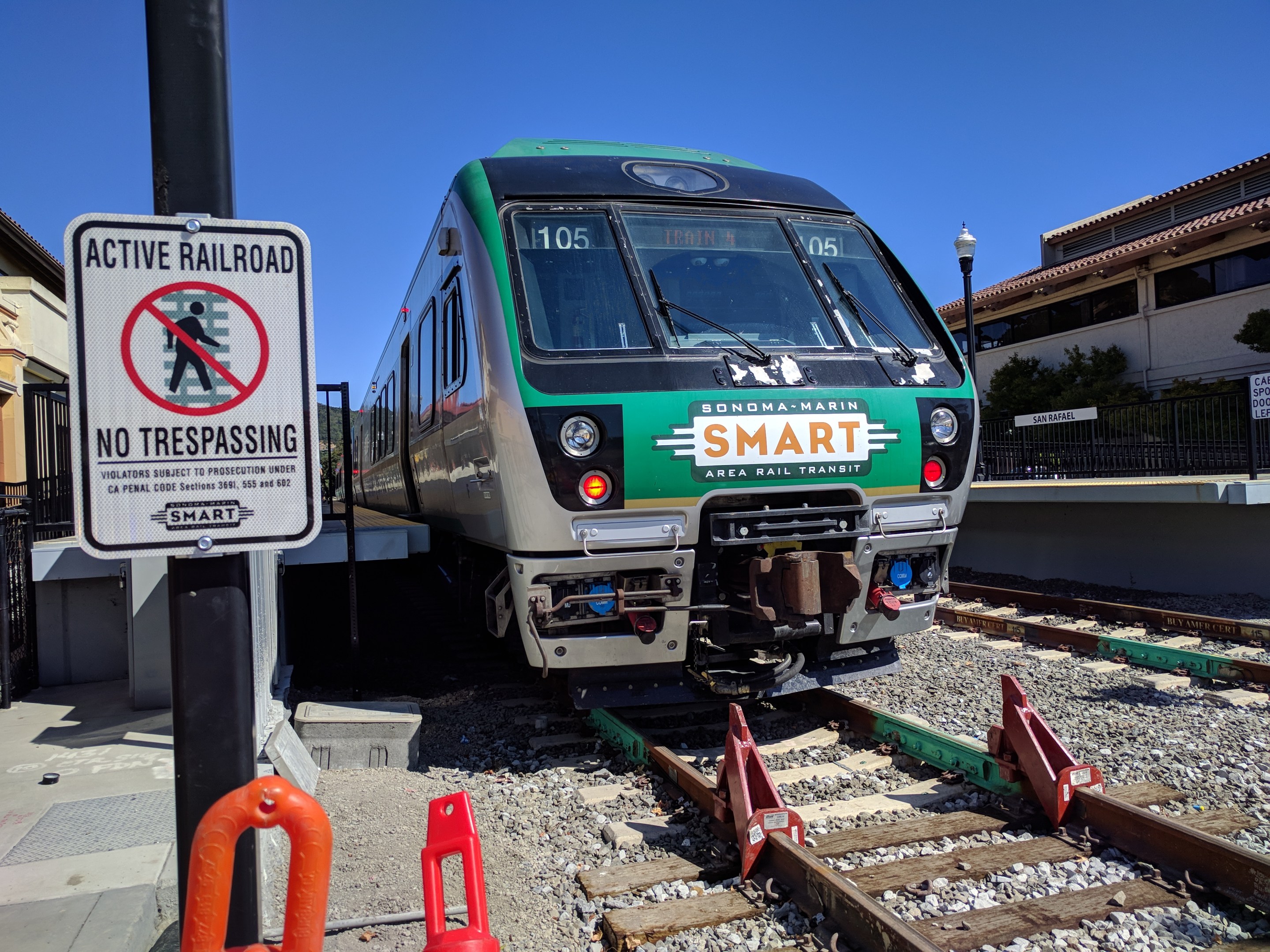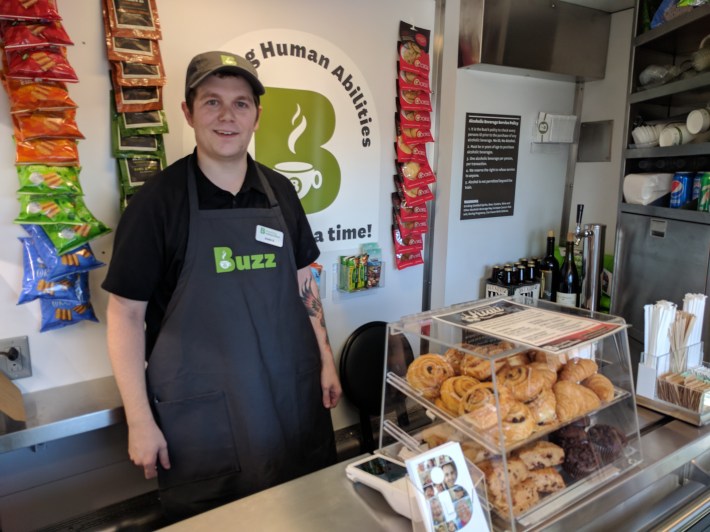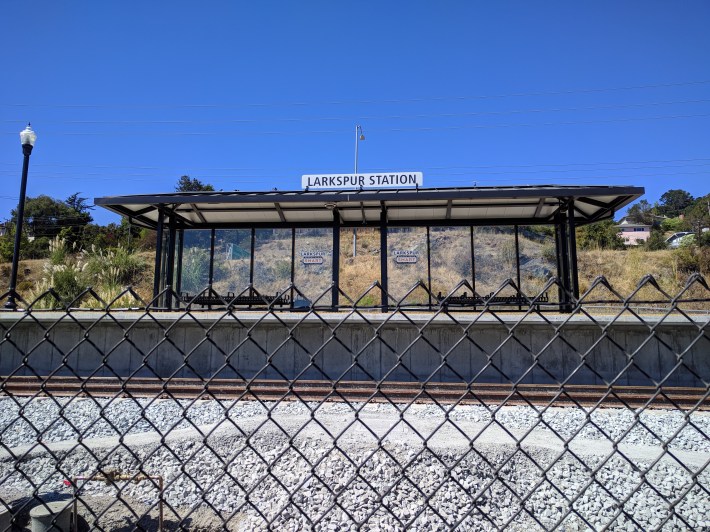Editorial: Larkspur Opening and Reflections on Rail
4:20 PM PST on December 11, 2019

A SMART train, waiting in San Rafael in Sept., champing at the bit to head two miles more to meet the Larkspur ferry. Photo: Streetsblog/Rudick
Note: GJEL Accident Attorneys regularly sponsors coverage on Streetsblog San Francisco and Streetsblog California. Unless noted in the story, GJEL Accident Attorneys is not consulted for the content or editorial direction of the sponsored content.
SMART, Marin and Sonoma Counties' commuter train, will celebrate the launching of service to Larkspur on Friday. With the opening of the Larkspur station and its connection to the Golden Gate Ferry, Marin and Sonoma residents will, for the first time in over a half-century, have a traffic-free option for travel between the North Bay and San Francisco.
This is a cause for celebration. SMART reached the million rider mark in its first year of service, and ridership is bound to go up as people fold the ferry connection into their travel habits, and the fledgling railroad rolls out expanded service and through-ticketing.
That said, it's probably a good idea to remember that SMART is actually not technically a new rail service--it's a restoration of part of an electric rail system that ceased running in 1941, one of the early casualties of the bad old days of the auto-über-alles policies in the Bay Area and throughout North America.

In a sense, the SMART train remains inferior to the historic trains it replaces--and not just in the relative breadth of service. SMART is diesel-powered, which means while it emits far less per passenger than automobiles, it's still putting poison in the air. The original Northwestern Pacific lines were electric (note the third rail in the above photo). There were also lines to downtown Larkspur (the old ROW is still visible behind the shops on Magnolia Avenue) and Mill Valley. The train station in Mill Valley is now a bookstore and coffee shop. In fact, there are vestiges of the old system all over the North Bay.

Imagine if the legacy rail system had been preserved and instead of rebuilding it, the North Bay was now improving it and extending it to the East Bay or directly to San Francisco? With electrification already in place, trains would be faster, more efficient, and quieter than what SMART runs today.
Nevertheless, the SMART train is a good first step towards restoring what was lost. For $500 million, the agency didn't have the option of fully building out a frequent, fast, electrified service. Instead, they built for reach instead of volume--SMART is 45 miles long, so it could act as a starter system for a huge stretch of the North Bay. Yes, it's currently too slow, low capacity, and infrequent to take a real chunk out of the dominance of the automobile. But now the North Bay is getting a glimpse of what it gave up--and what it can have again.
And upgrades are coming--especially if a multi-billion-dollar measure to upgrade transit throughout the Bay Area comes to fruition.

The agency is already planning to expand the schedule. Unofficially at least, a SMART train official told Streetsblog they hope to restore electrification, double-track the system to increase capacity, and generally build it into a service that runs far more frequently, all day long. For now though, with its snack car and cushioned seats, SMART has shown that transit doesn't have to be spartan and utilitarian. It's okay for transit to be comfortable and nice.
Today, it's common to hear how driverless cars will make public transit obsolete. Let's not repeat the mistake that freeways and cars and buses can solve all our transportation needs. Rail has an essential place in urban environments, suburbs, and small towns--and as anyone who has been to the great cities of Europe and Asia knows, high-performance, electrified rail is fundamental to solving our transportation problems.

The SMART train is a foundational step in that direction. And upgrades, expansion, and higher frequencies can't come soon enough.
Tell us what you think. Is the SMART approach smart? What should be the next move for the SMART train? Post your thoughts below.
On Friday, December 13, at 1:00 p.m., SMART will host a Ribbon Cutting Ceremony for the Larkspur Station, followed by festivities at the Marin Country Mart. Full service to Larkspur will begin Sat., Dec. 14
For more on the history of rail in Marin, check out this piece from Marin Magazine.
Stay in touch
Sign up for our free newsletter
More from Streetsblog San Francisco
Commentary: Making Valencia Better for Business
Curbside protected bike lanes with curbside parklets deliver on much-needed economic benefits for merchants while ensuring safety for all




